Nearing the end of February and still not “free” of Gauteng, we got out of there again and took a drive to Pilanesberg National Park.
We booked for three nights at the Manyane Campsite, which is situated just outside one of the official entry gates on the east side of the Park. When we arrived at the gate of the camping area, there was a true welcoming committee of springbok waiting and grazing and it looked as if they were not really bothered by all the vehicles going in and out. As it was Friday afternoon by then, we made ourselves at home on one of the many sites and chilled with a glass of wine around a braai fire.
The next morning we got up reasonably early and drove to the park gate. When we arrived there however and wanted to present our (one annual fee for as many entries in National Parks as you want), we were informed that Pilanesberg is NOT a National Park, but a Provincial Park / Nature Reserve. The poster on their window mentioned “National Park”, but who’s to argue. The map we bought said ”Nature Reserve”. We paid our dues and entered.
As per usual when we enter a wildlife environment like this, our hopes are always high. When they mention ‘Big 5’, you want to spot the big cats so badly, because they usually are way more elusive and difficult to spot than say… an elephant or even a rhino. And of the other animals like zebra, buck, blue wildebeest,… there are usually much more abundant than the big cats. So yes, the big cats are usually the cherry on top for anybody driving around in a game reserve. Back to game spotting in general: when we don’t see anything in the first five minutes we get despondent. Until we see the first buck or zebra… then we get all fired up and start our lookout strategy in all earnest.
This was our first ever visit to Pilanesberg and it didn’t disappoint. Our first little loop we took, brought us right next to a dam with a few hippo’s snorting and enjoying a chill in the water. Driving past the other dams in the following few days, we saw hippo’s in each and every dam. The bird hides on various of the dams bring you up close with life on and around the water. Besides the hippo’s we couldn’t miss (be it far away on the other side of the dam), we saw water turtles cavorting in the water, the shadow of what we thought could possibly have been a crocodile and spiders, lizards, dragonflies and damselflies making themselves at home at the bird hides.
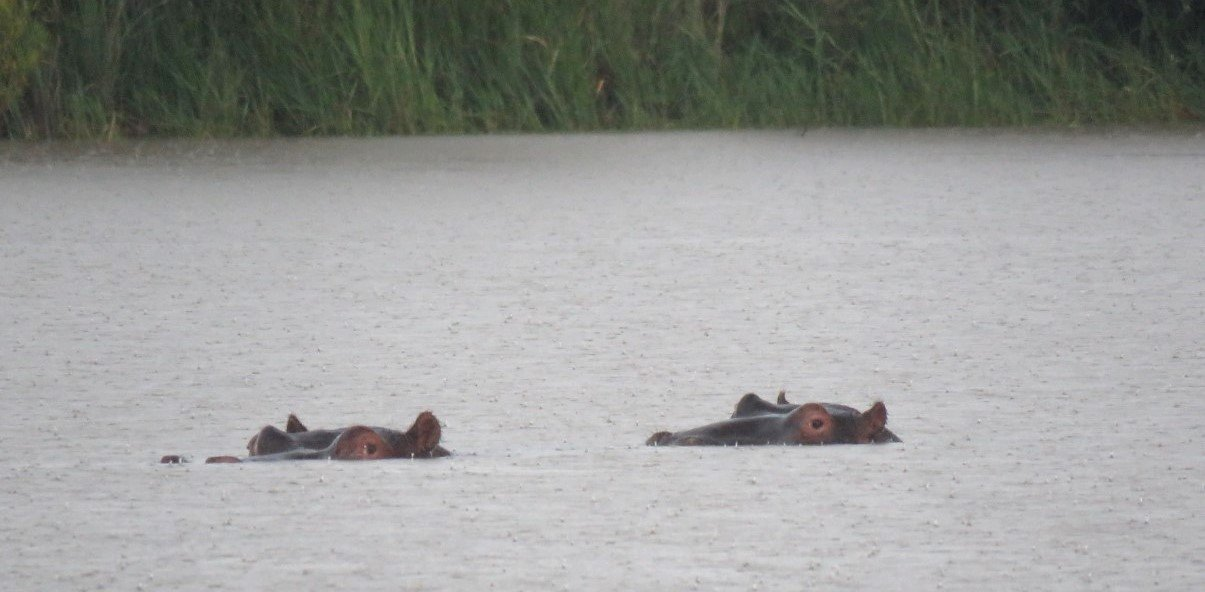
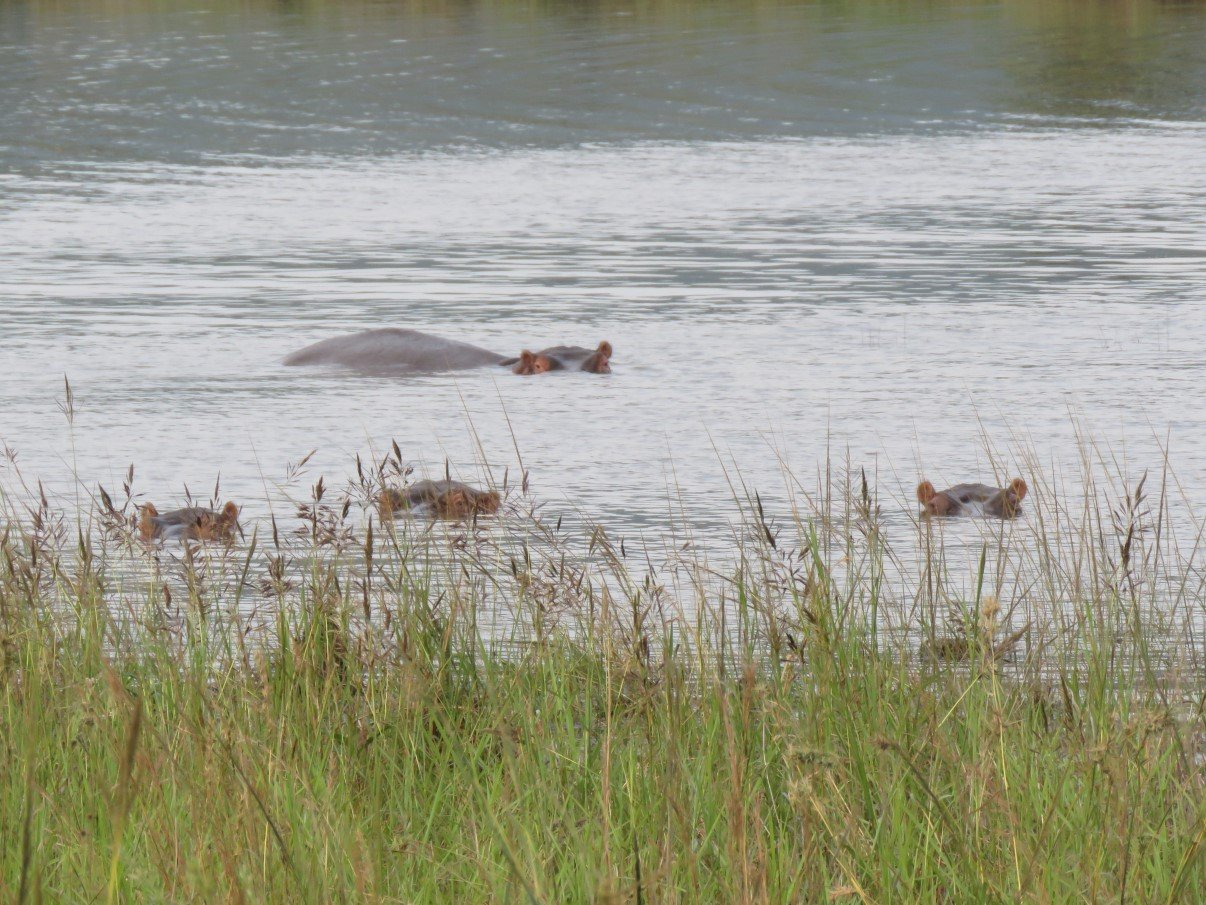
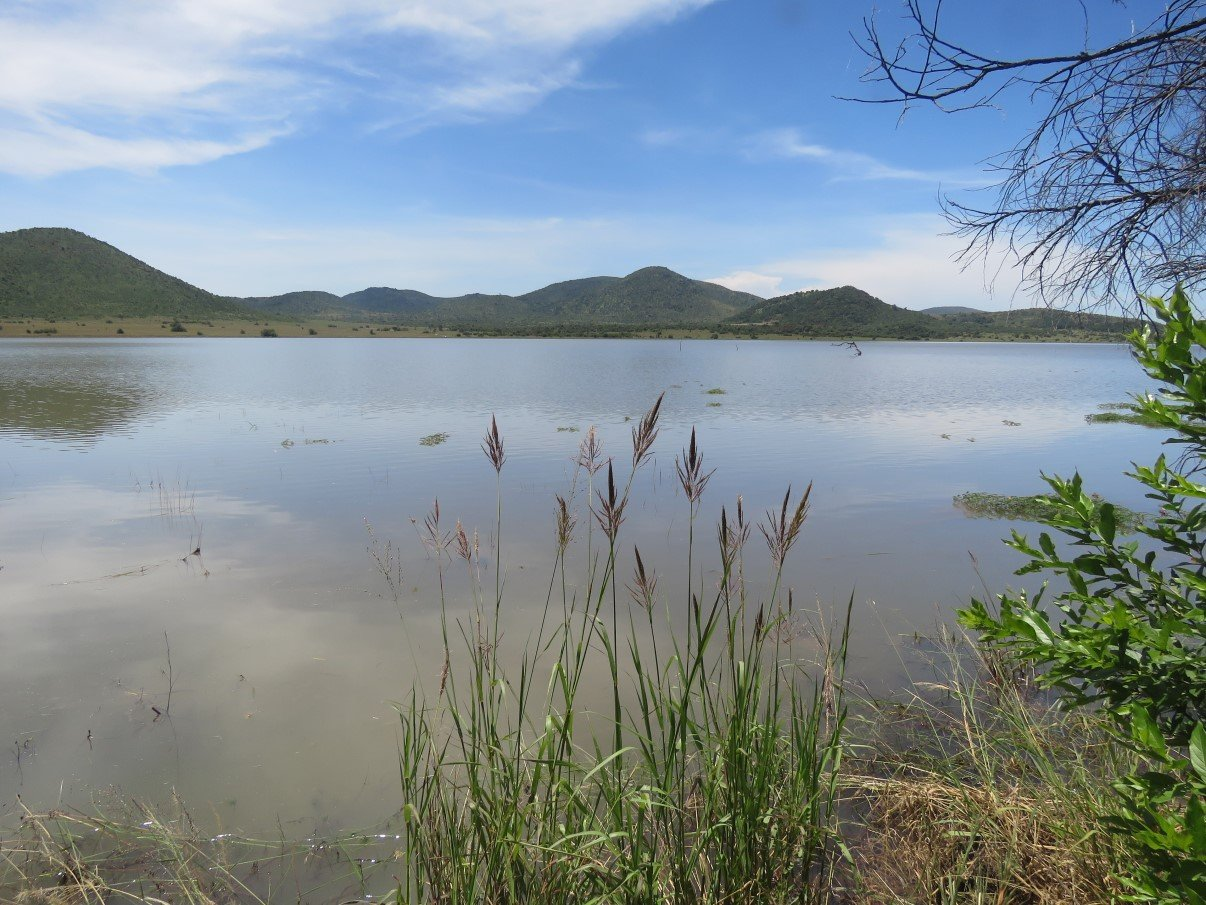
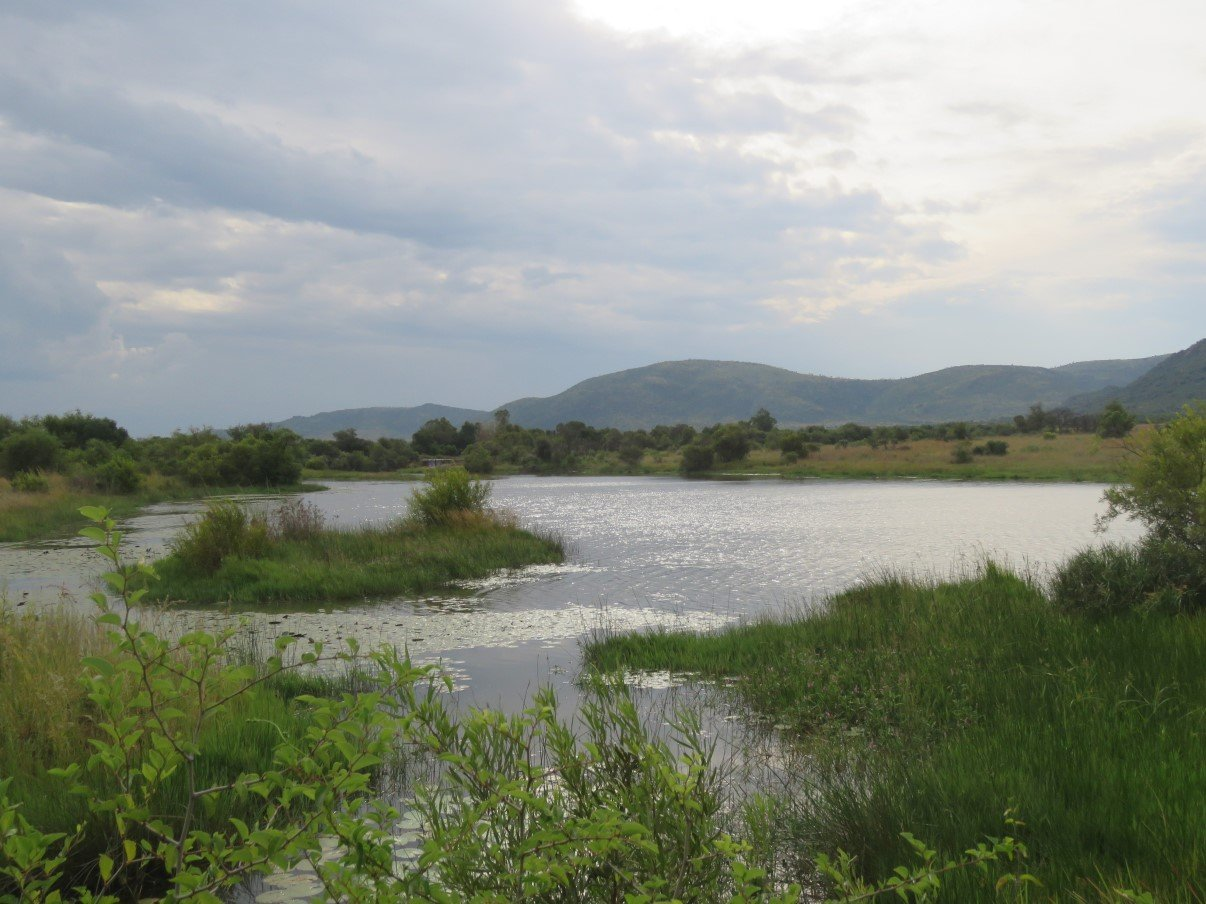
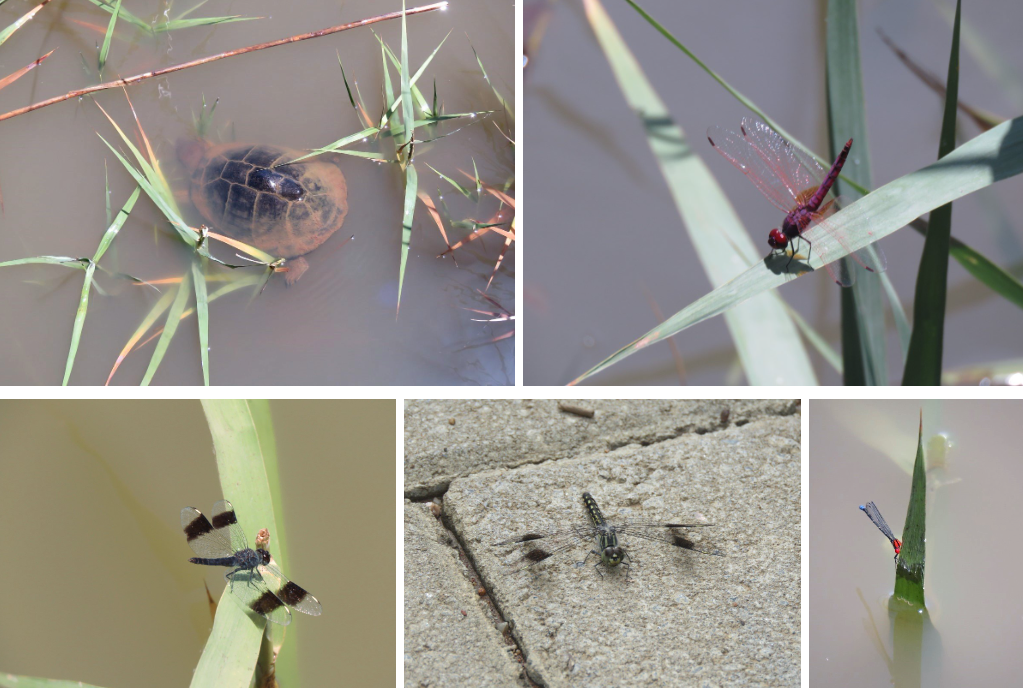
The park is dotted with historical and geological sites. We stopped off at the one indicating “iron age site” and walked around the remains of a homestead. We found what we presumed were the remains of the hut that was mentioned on the sign board: a wall of stacked stones overgrown by the bush. Stefaan got stung by something that made his ankle swell up to balloon size for the next day or two. Luckily it still allowed him to drive, because some paths in the park are quite badly rutted. Add that to the fact that it had been raining quite a lot in this region (and while we were there), there were some places where we happily slipped and slithered on the muddy tracks.
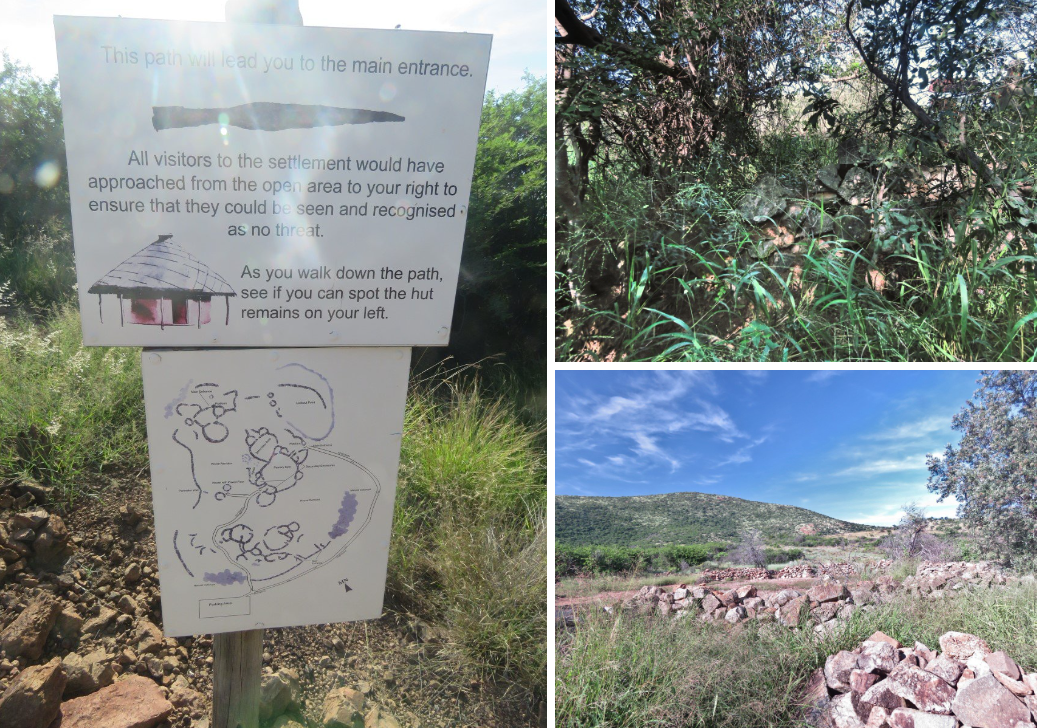
Although we are not really birdwatchers, we caught ourselves spotting a VIB (Very Important Bird – a fish eagle) perched on a dead tree, but also stopping for the smaller birds that were flitting around the bush or dams. Especially the guinea fowl were super cute when they kept up a stiff trot in front of Trokkie, without seemingly being scared by this big mammoth.
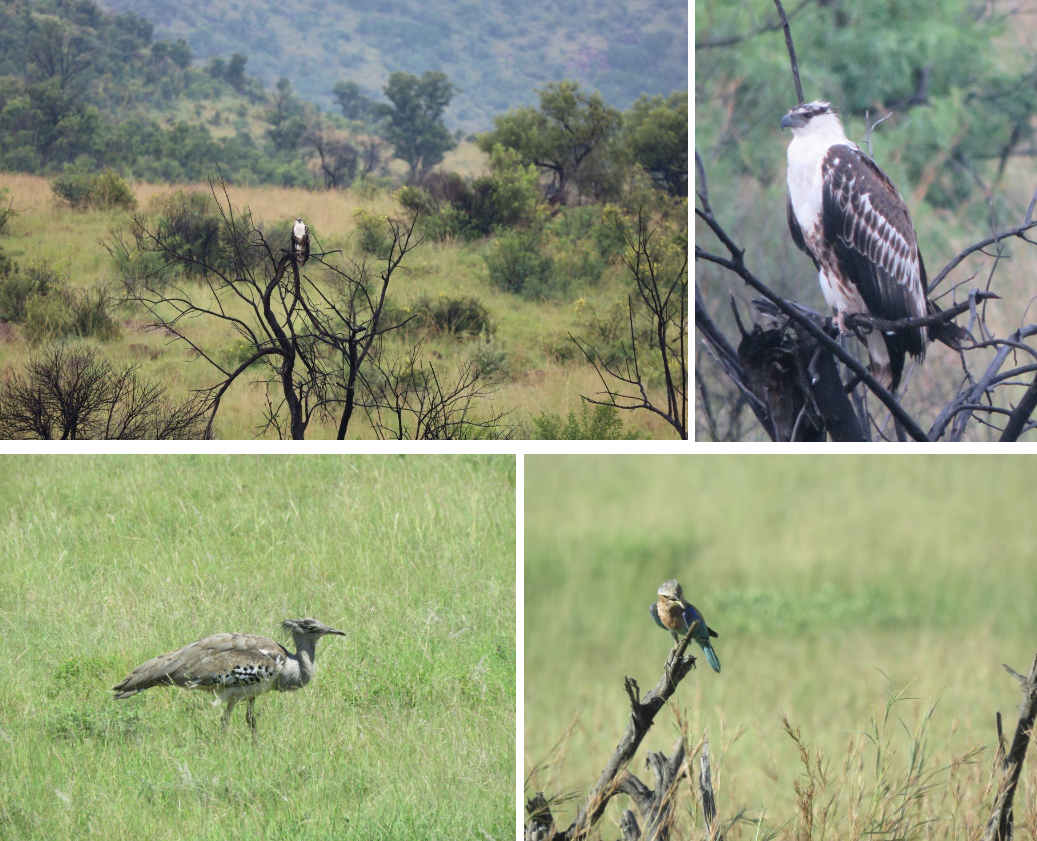
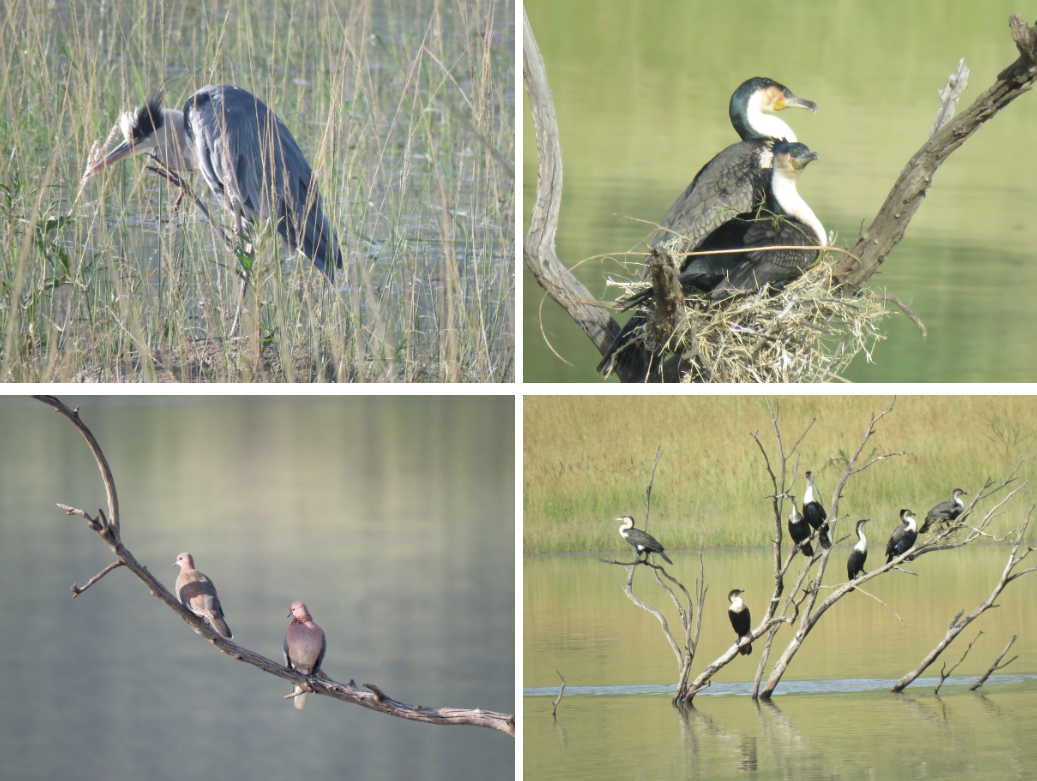
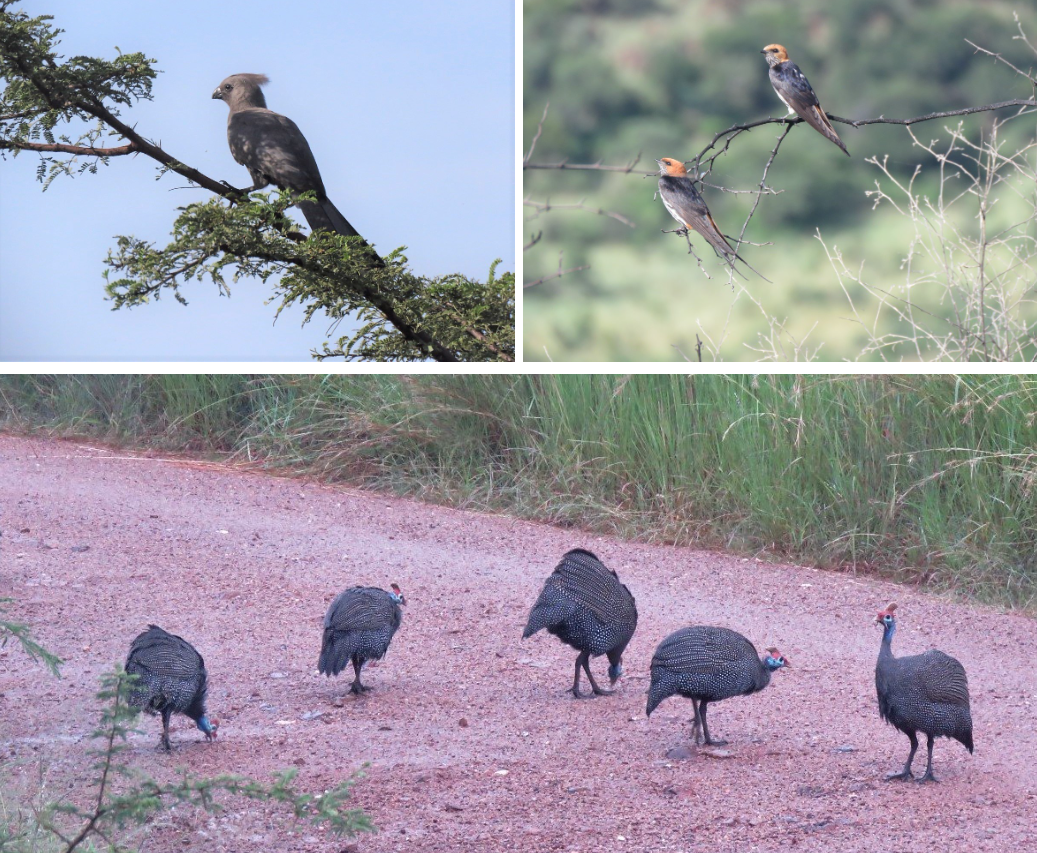
Driving around in the park takes you from plains, that look like being taken straight out of the movie “I had a Farm in Africa” with herds of blue wildebeest, zebra and springbokkies amiably grazing in the gently waving yellow grasslands to rocky hills and lush shrubland where you could imagine King Mufasa showing his lion cub Simba to the Animal Kingdom in the Lion King movie!
Believe it or not, in this thick bush like this you can miss a rhino even if it is grazing two meters next to the roadside. We saw the odd few giraffes from a distance and even an elephant or two even further away.
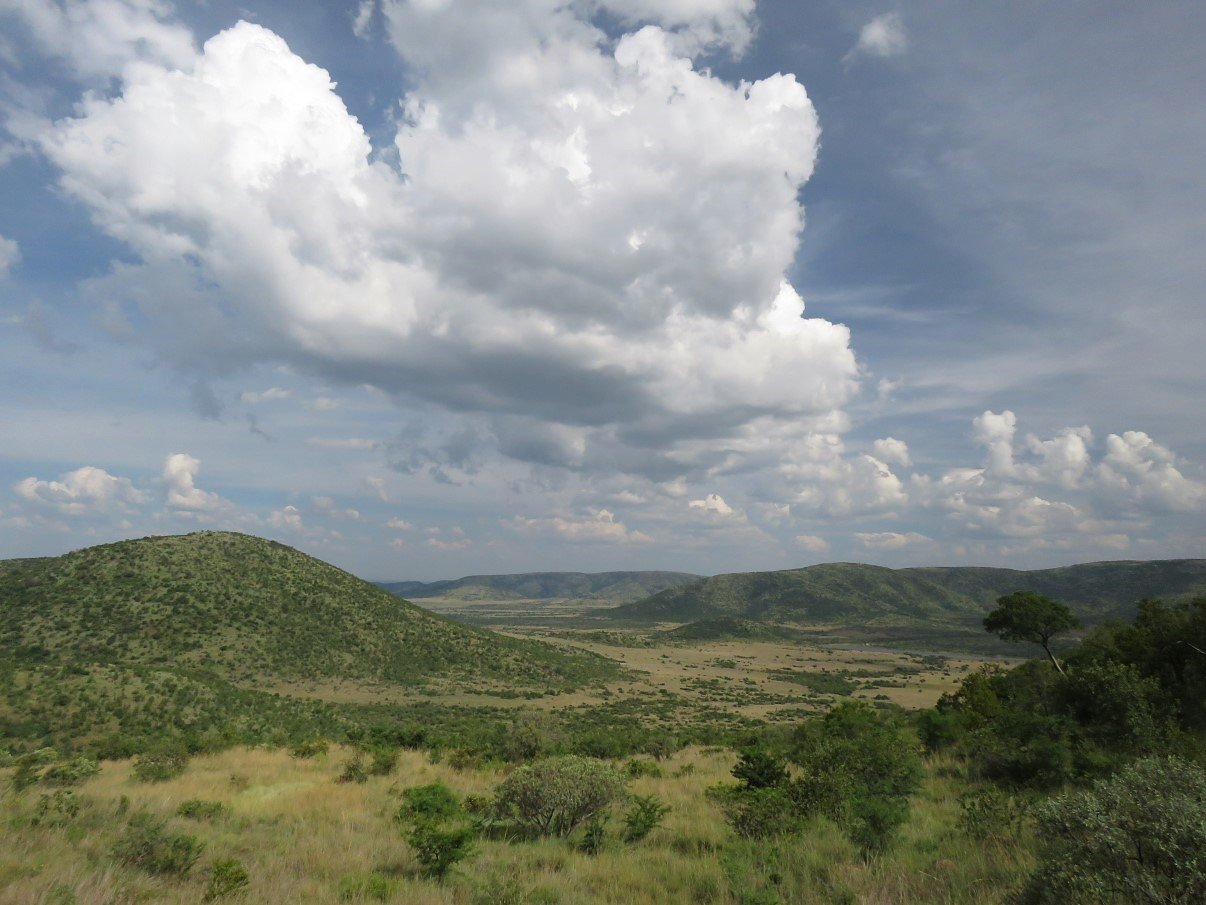
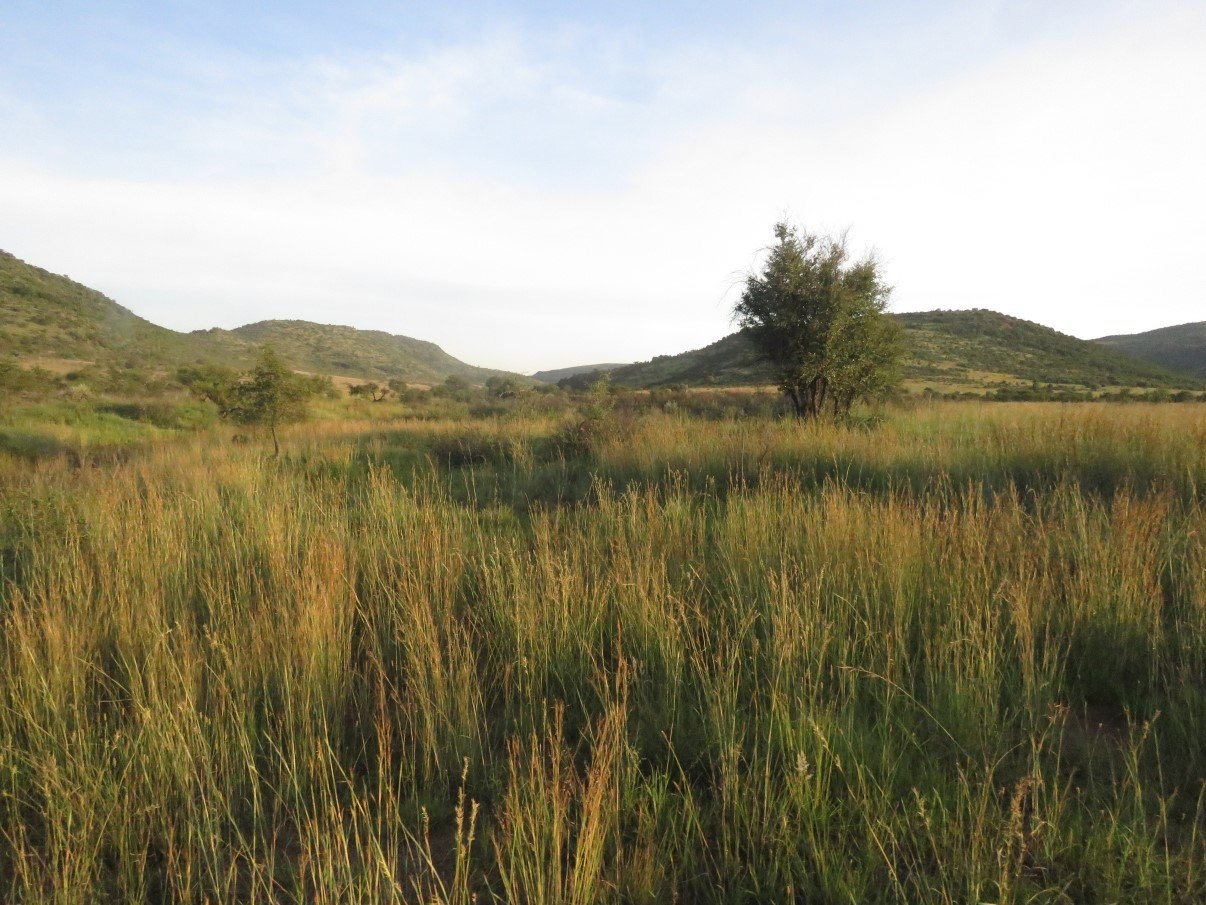
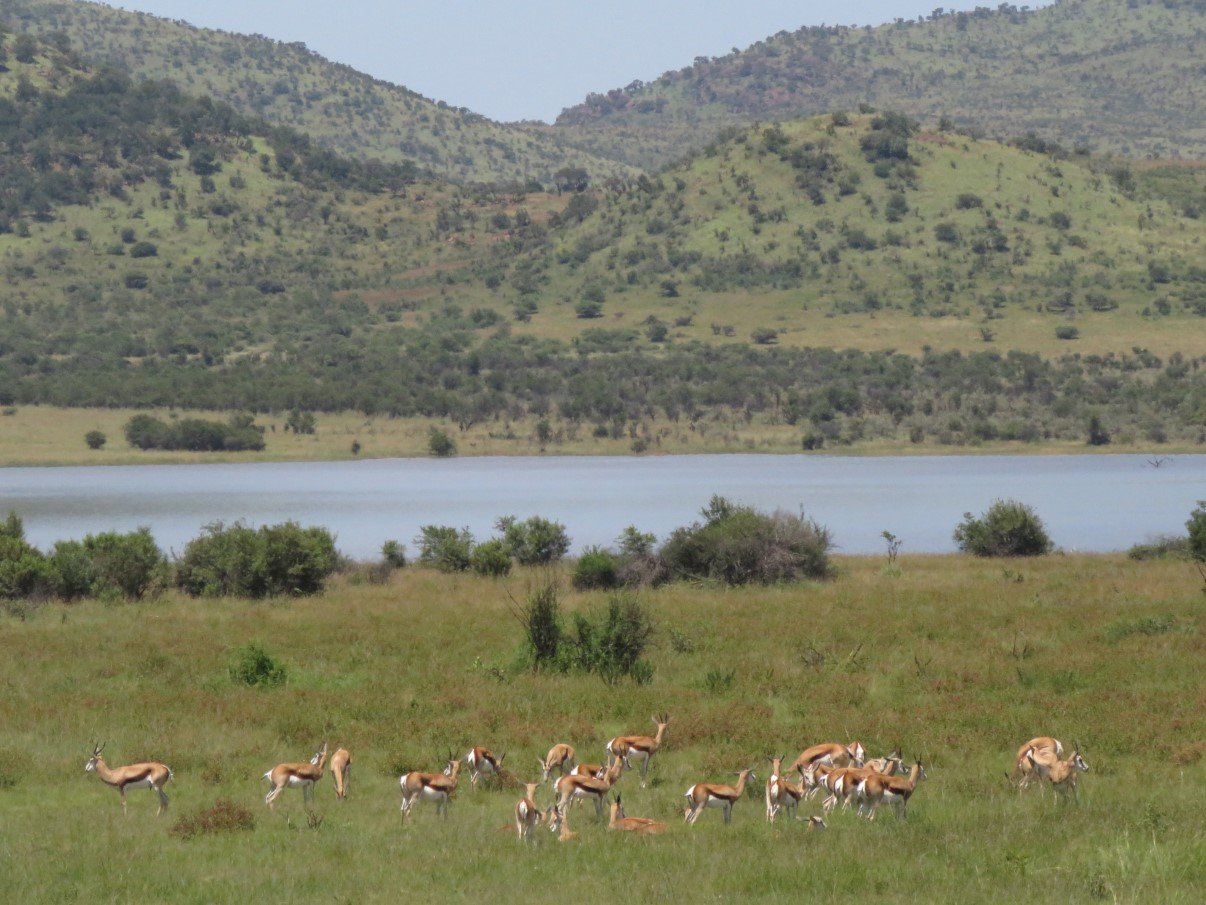
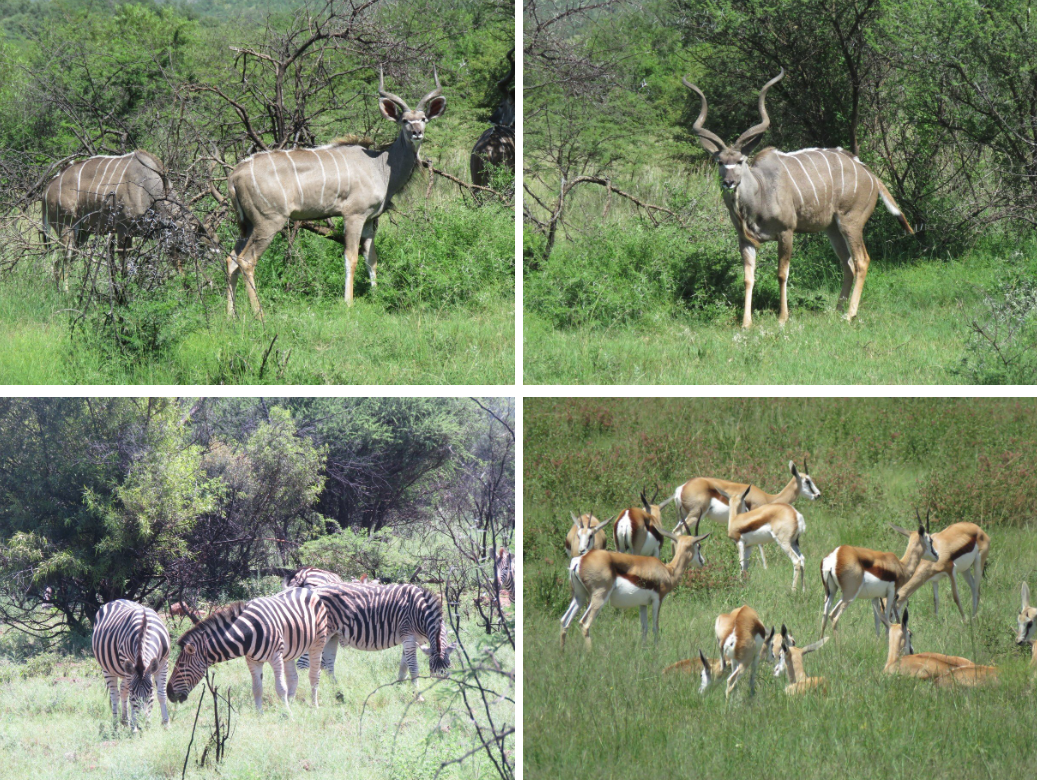
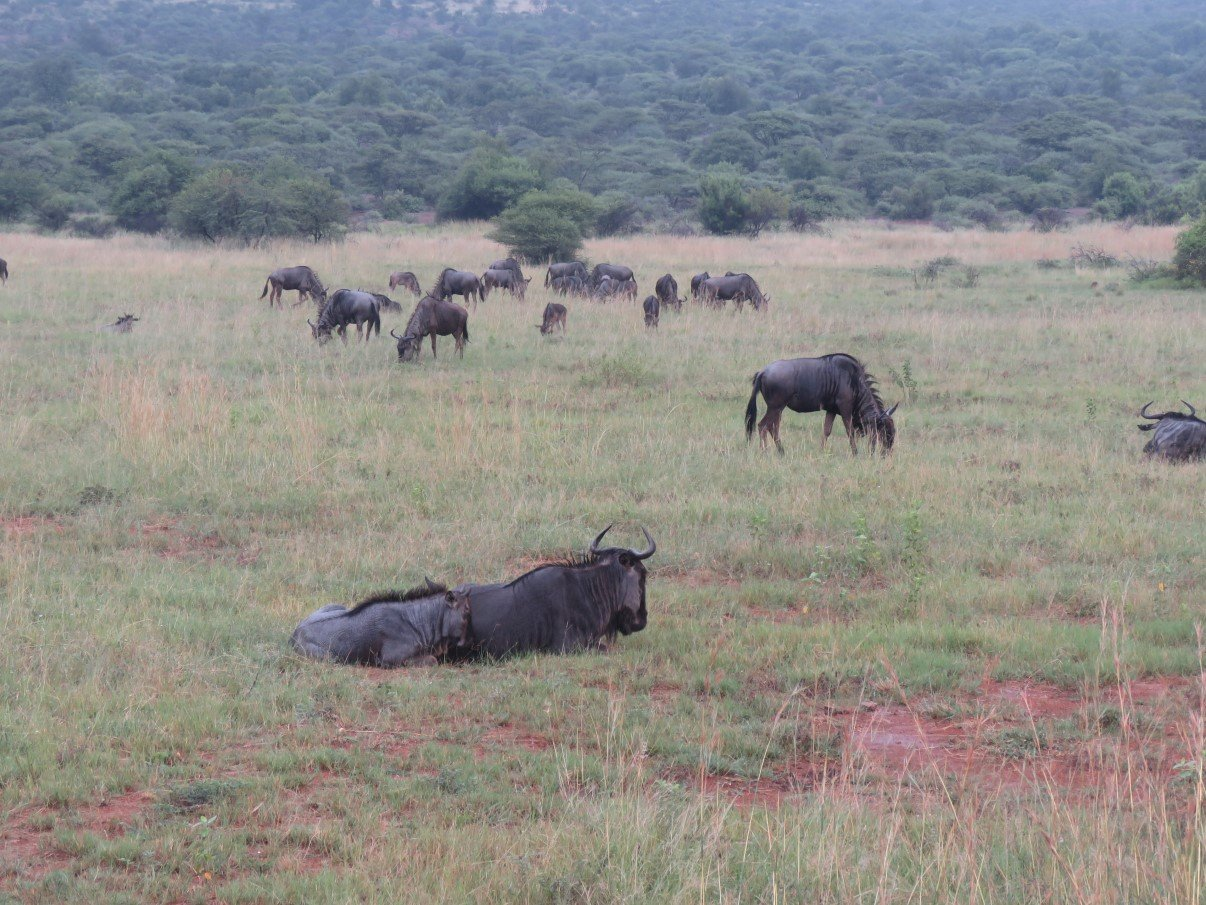
We also saw quite a number of rhino’s… all without their horns. It’s a pity that nature conservation has to take this drastic step in order to protect the rhino’s lives from poachers.
And where there are elephants and rhinos there is big, fat dung and the dung beetles line up to go to work. One got lost however, flew inside the truck and landed on a cap. We presumed he would prefer elephant dung over our company so we set him free.
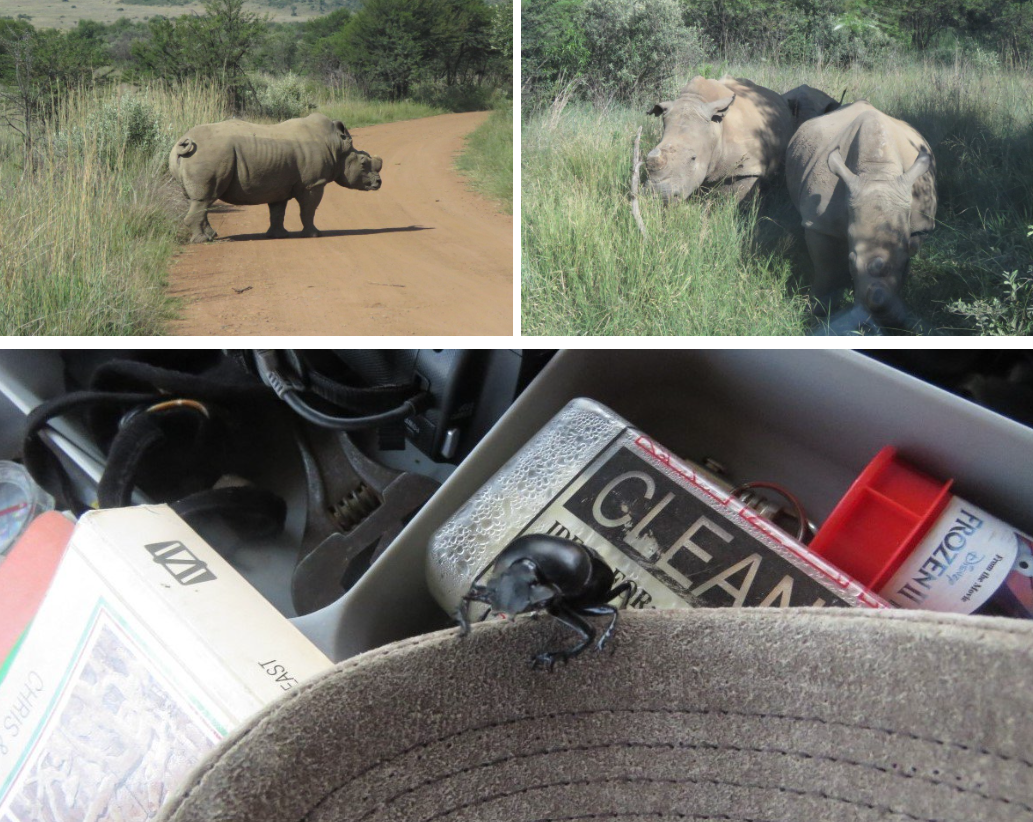
The game spotting strategy is not only focused on unrelenting scanning of bush and veld for any movement of the well camouflaged animals. No. The strategy is expanded to spotting where more than one vehicle converges on a particular spot. Then you put pedal to the metal (within park speed restrictions of course) to get to where other cars are looking at something. The biggest crowds usually gather by any of the cats… because they are so elusive and usually gather in much smaller numbers.
The first day, an SUV coming from the other direction, gave directions to where a lion and lioness were lying under a tree: “we would see the cars!” We got there, but the cats were actually pretty far away in the field and barely visible. Only when the male got up for a bit of a disabled walk, could we see them fairly ok. Later that afternoon, when we were actually on our way to the exit, we spotted another convergence of cars and heaps of safari vehicles at a particular point and joined the pack. That’s the thing with the cats: if one is spotted, vehicles descend on it like flies on dung!
When we arrived there was a traffic congestion of sorts with easily 20 vehicles vying for a good viewpoint. Because we are at least one meter higher than anybody in a normal car/SUV, we have a better vantage point from the top. There were indeed a lion and lioness reasonably close to the side of the road- maybe about 10 m. When the cats play hide and seek in the long grass, they are not easy to spot. We were lucky that, from our higher viewpoint, we could just see their heads popping out of the tall grass, but we understood the frustration of the lower vehicles. We could only point, but they didn’t see anything but maybe a shadow or slight change in colour. For us: definitely a highlight to end our first day!
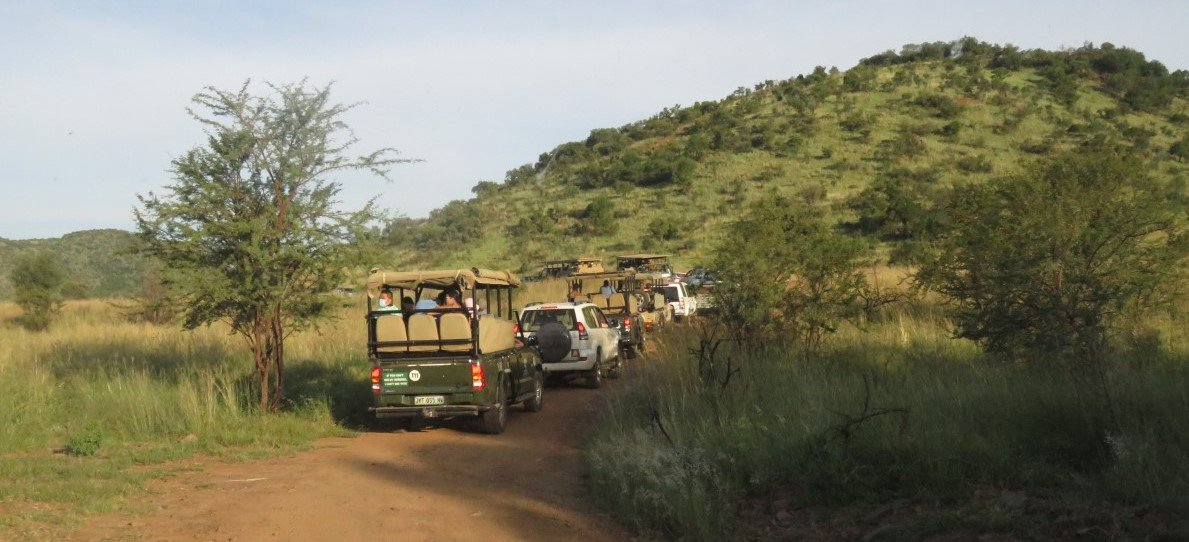
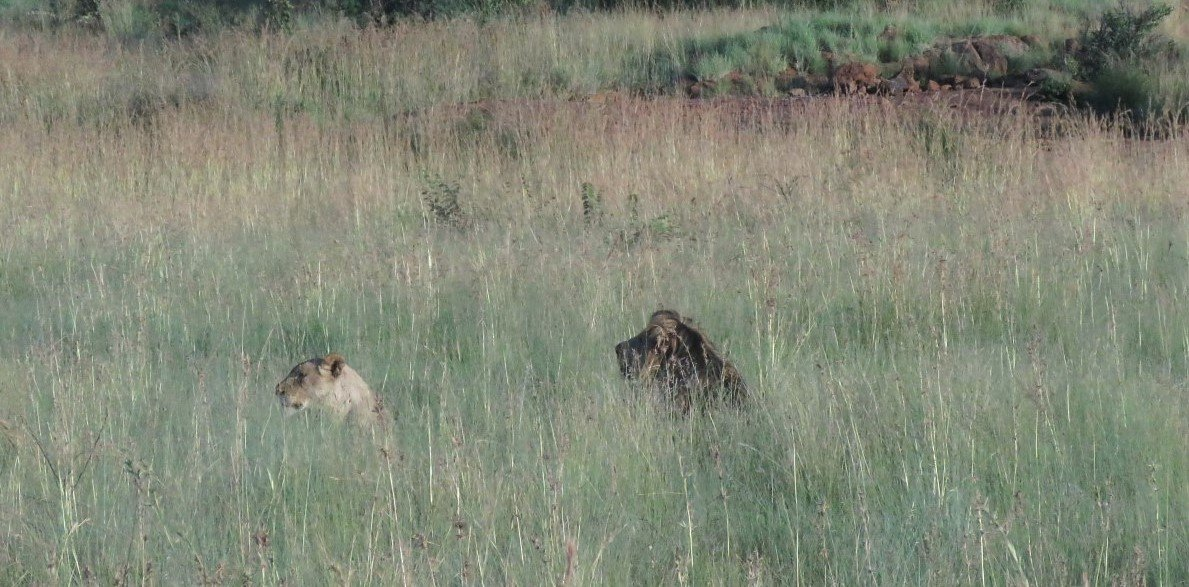
When we arrived in camp and found ourselves a parking spot for the night, our neighbour-camper came to chat. It seems that Herman and his family are staunch visitors to Pilanesberg and know this place like the back of their hand. His mom joined in the conversation and before we knew we had gotten all sorts of good advice where to find the buffalo’s and the cheetah’s.
So… next morning we were up again bright and early with big hopes for the day’s viewing. We started off with looping around the dams, hoping for a crocodile or so and eventually ventured out towards where we were told was buffalo and cheetah territory. We saw our fair share of hippo again, because they seem to like their dams and see no reason to move!
Passing through buffalo and cheetah country (where we actually didn’t see anything at all) we took a coffee break along the road with magnificent views over the mountain side. Just as we continued, an SUV coming from the other direction explained there were cheetahs a bit further up the road. Pedal to the metal again and true as bob: there they were!
With our hatch that can open on top, we have great views right over the other vehicles. So Stefaan usually tries to park on the verge on the other side of the road, so that smaller vehicles can stand in front of us. We still had great views of the cheetahs and it was exciting to initially see one, then two, three and four, until in total five got up and walked away. All vehicles around us turned to follow the cheetahs but we decided to go the other way. With 10 or more vehicles driving behind the cheetahs walking down the road, it would be the first one or two that might have good views and the others wouldn’t. Until of course the cheetahs decided to chase and hunt and make a kill… then we would have missed that!
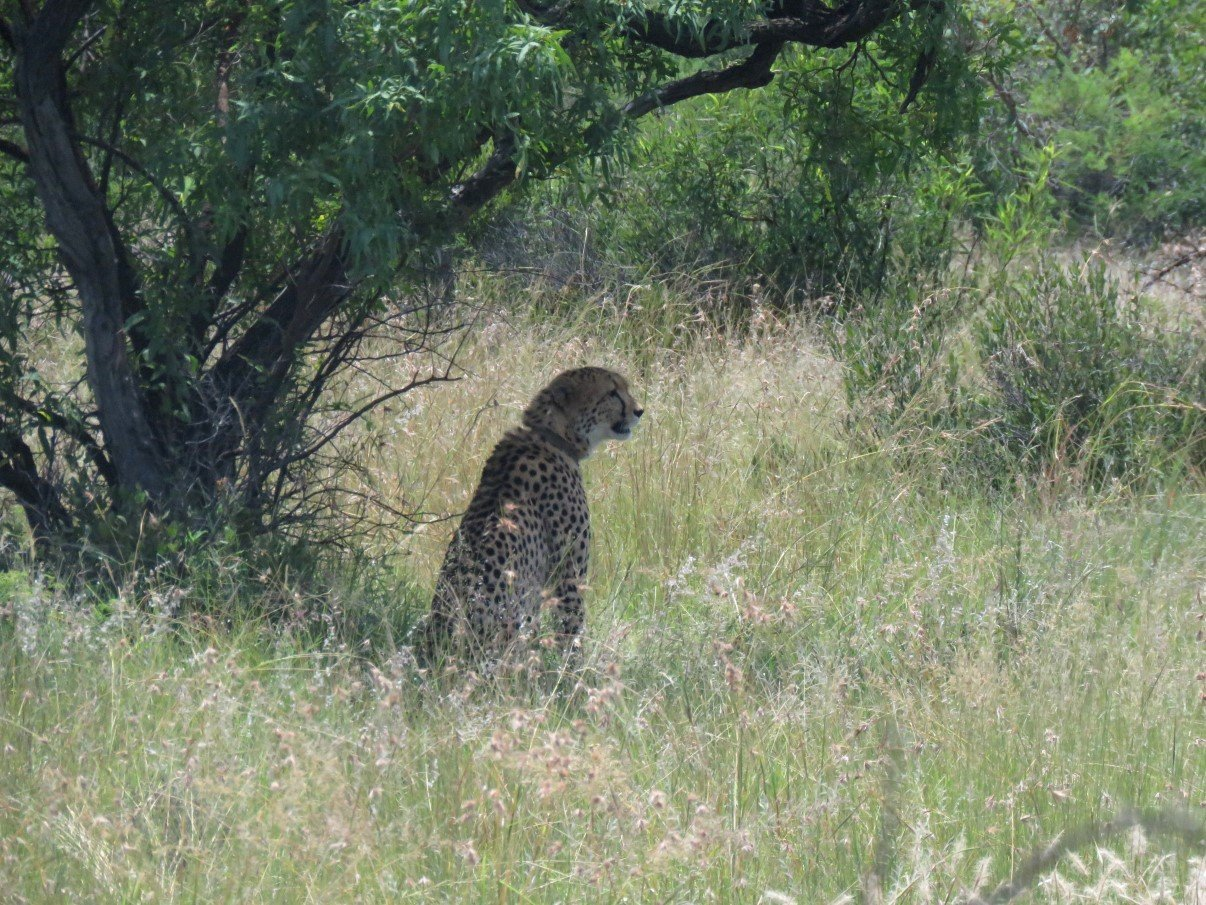
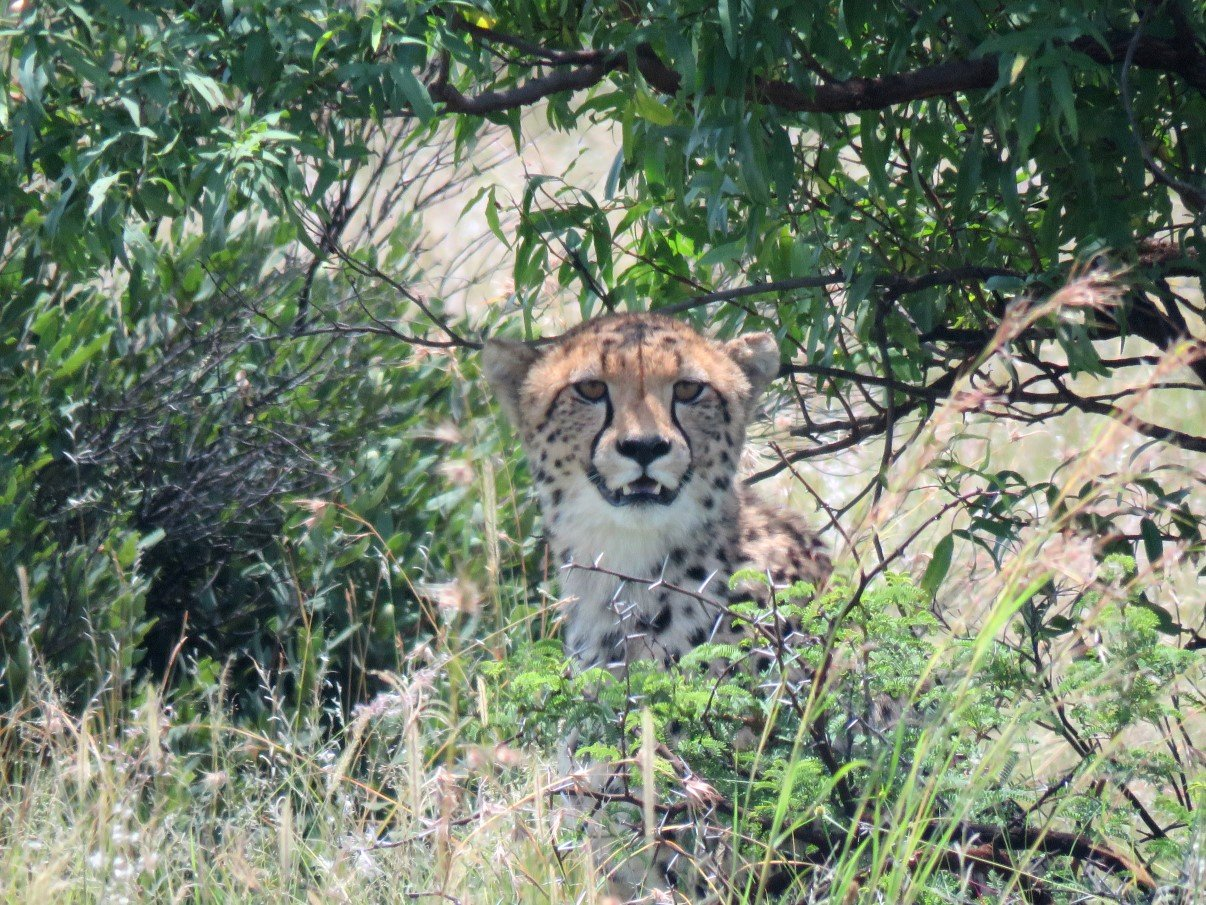
We left the park with the usual sightings of zebra and wildebeest and an elusive tiny duiker. Back on the campsite, we decided we would spoil ourselves with supper at the restaurant and invited fellow travelers to Trokkie for a cup of coffee afterwards.
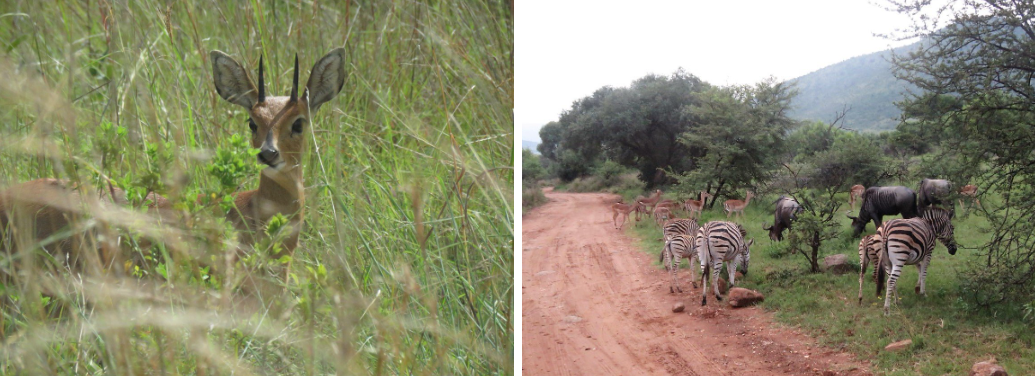
As there was nothing rushing us out of there, we decided to go for another round in the park the following day. By then it was Monday and we could see from the desolation of the camping site, that there would be much less vehicles driving around.
When we passed a fair sized herd of blue wildebeest grazing with a vengeance, we decided to follow their example and have a bit of lunch. Luckily we can step from the cabin into the house! We all enjoyed our lunch. When they decided to move on, we got going in the opposite direction.
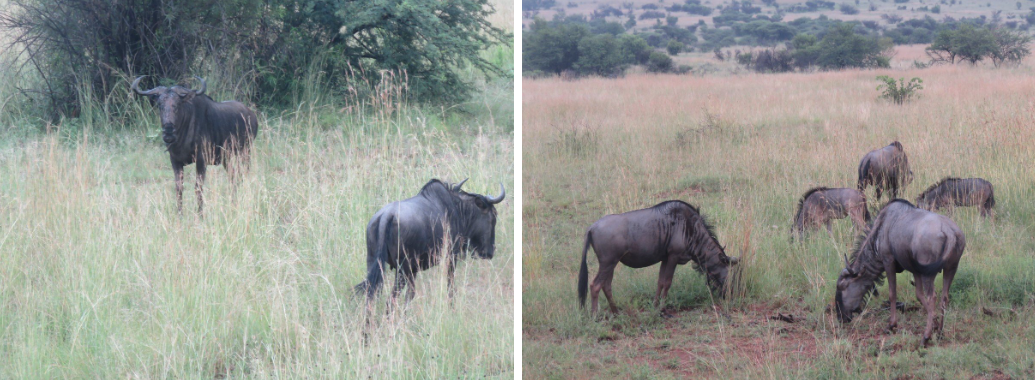
We stopped at one of the bird hides again, where (after many tries in the past) I eventually got halfway decent photos of a red bishop. Inside the hide, a few freaky spiders were waiting for prey to fly in their webs and a solitary lizard on the board walk didn't seem too fazed by our footsteps.
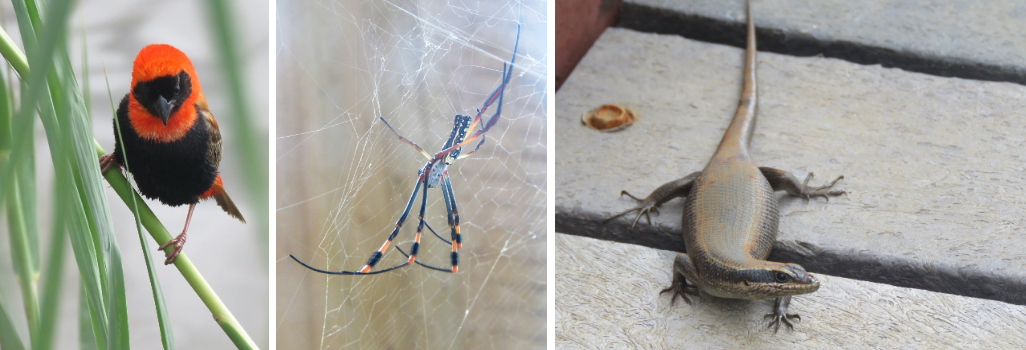
We took another loop around the dam. According to the map brochure, the Mankwe Dam and surrounding grasslands is main territory for the four lion prides in the park. So yes, this was a popular route for most visitors.
The driver of a vehicle we passed, flagged us down and said they had seen a brown hyena further up the track. By now we realise that, a single animal on the move, seen by one person in such a vast territory, has most probably long since disappeared by the time we would arrive. We didn't have high hopes, but we kept on looking. This time we were lucky. All of a sudden we saw a biggish, darkish animal trotting on the dirt road a fair distance in front of us and realised it was the brown hyena. Unfortunately it veered off the road and started climbing the side of the mountain and soon enough it had disappeared behind the trees dotting the mountain slopes. Although only from afar, we were happy we had seen it!
Around one of the bends, we saw a few vehicles driving very slowly and we saw a young leopard walking in the road. Until it most probably got tired of this string of cars following him and he walked off the road into the bush. He walked for a while on a parallel track but eventually disappeared into the bush.
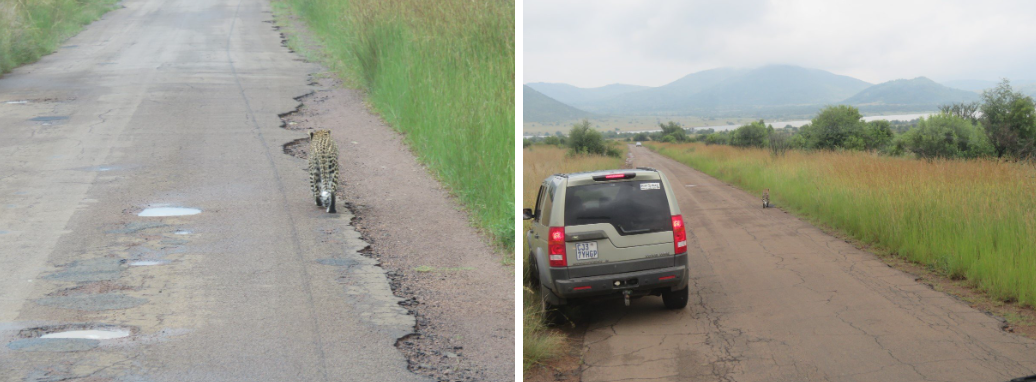
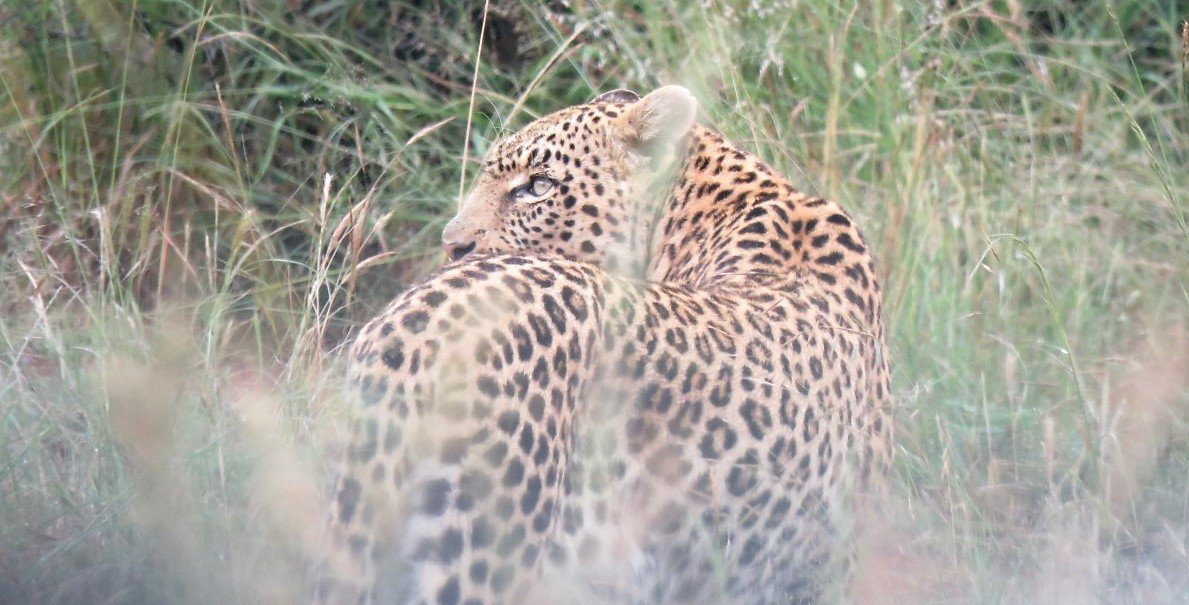
We slowly continued and decided to take the next right to make a loop around the area where the leopard had disappeared. Driving very slowly we spotted a stationary vehicle just up the road. The woman pointed to a tree less than 5 meters from the road. Initially we stared at the tree not really getting what we were supposed to be seeing. Until all of a sudden we saw a certain pattern between the leaves that was not branches or sky: we could see spots! When we started looking more intently, we saw her move and the whole jigsaw puzzle came together.
All of a sudden we saw the whole picture! A leopard was lazing about on a tree branch, just like in the movies. We parked as close as possible, nose to nose to the other car and sat back. I think the other vehicle might have had a better view of the leopard as a whole, because from our side she was a bit hidden between the leaves. Until she decided to sit straight up to gaze over the plains in search of prey. Yes, she kept her eyes on her visitors too, but was mainly focused on the far horizons.
That was a most amazing view ever! Yeah,… the cheetahs we saw the previous day had also been a serious exciting moment, but they were a bit farther away from us in the bush. This leopard in the tree was so close we could almost touch her. Not that we would attempt to… but we almost could!
More cars showed up and all of us were mesmerized to see her so close by. Sometimes you wonder what these animals think? Obviously they must have gotten used to cars sitting on there doorstep at any given time.
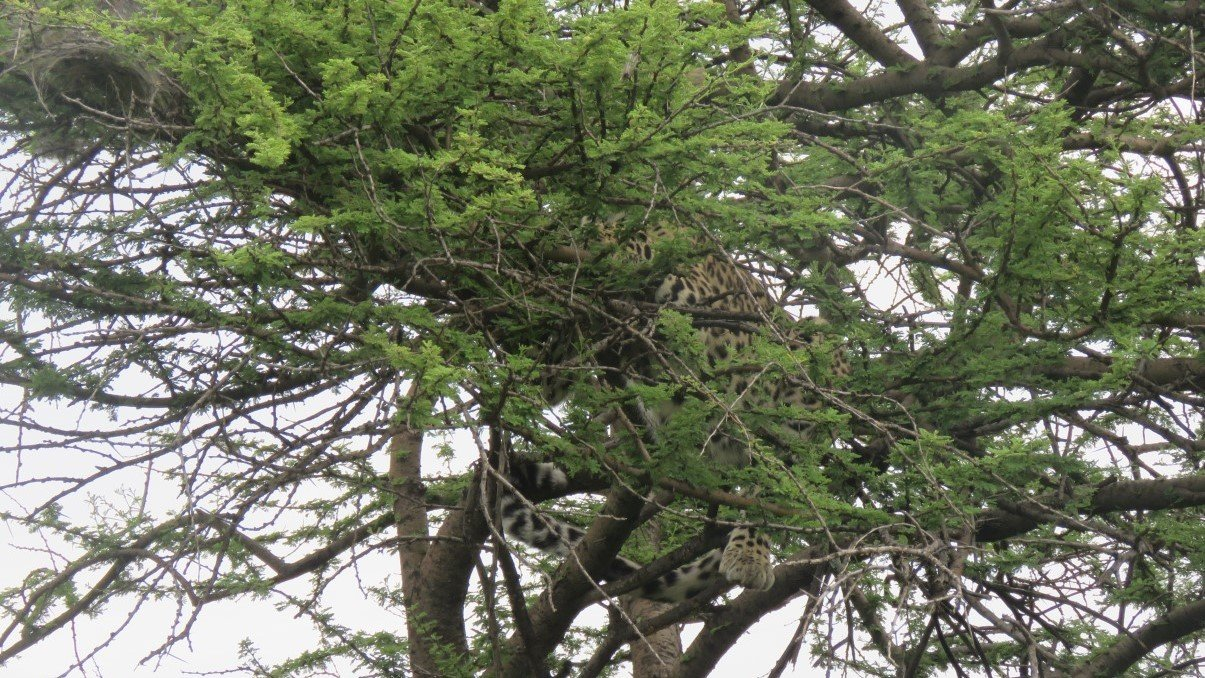
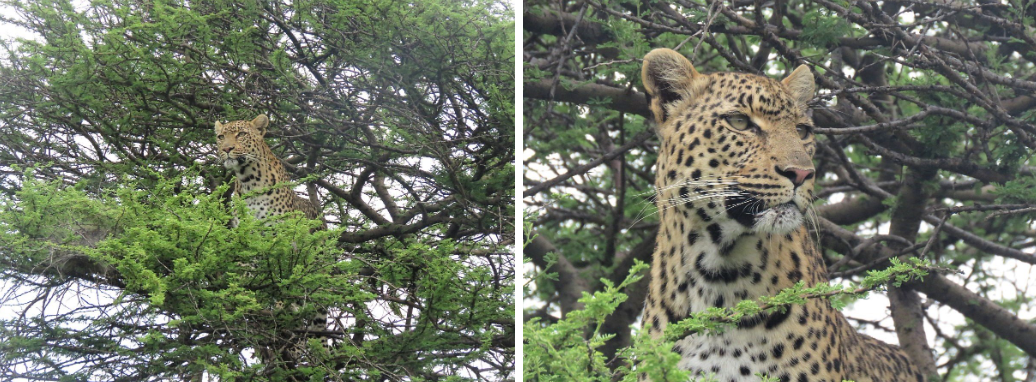
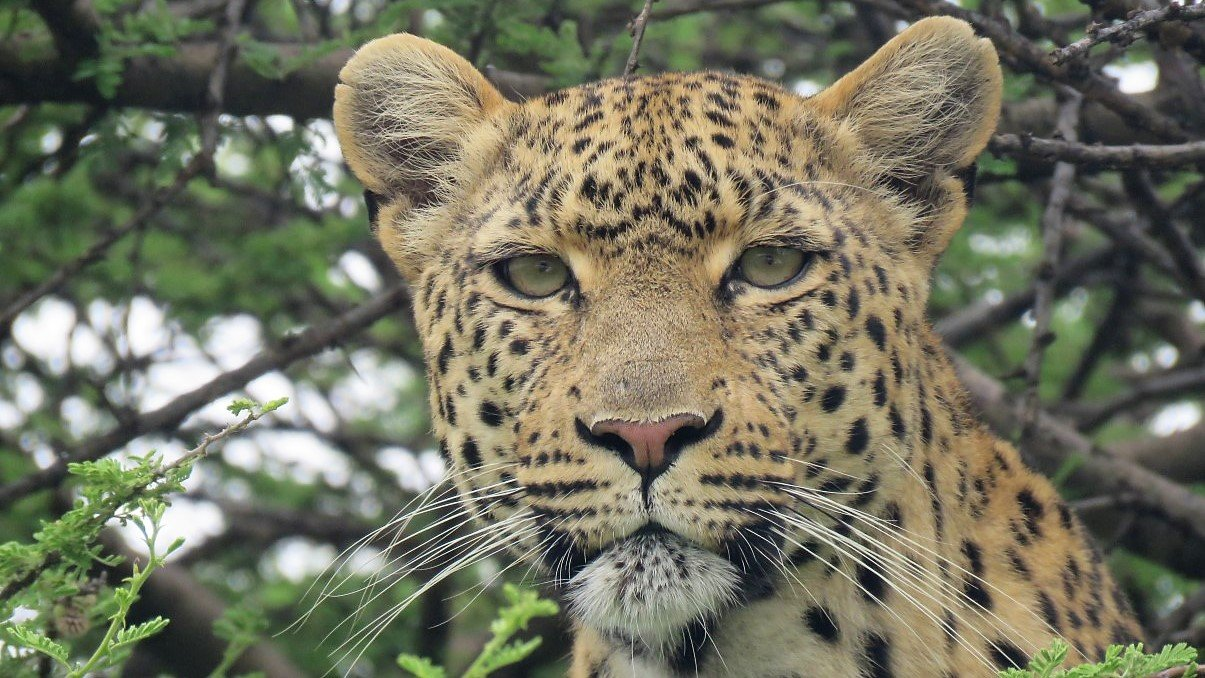
Eventually, she must have gotten tired of hanging about in the tree and got out for a walk down the road. Our little procession of cars followed her religiously, until we presumed she disappeared into the bush, because the vehicles in front of us started driving faster again.
That was a serious highlight of the day and, being late afternoon by then, we planned to get onto one of the main roads and drive back to camp. But just past the point where we should have turned right, we saw- once again- a whole heap of vehicles together. We caught up quickly and only then did we figured out that several of the vehicles were reversing. When we looked again, we saw why: a serious sized elephant bull was walking in the middle of the road with a string of vehicles in front (who were now reversing) and behind him. We wanted to just park on the side of the road and let him pass, but the driver of another vehicle told us that the elephant had “rubbed himself” against one of the safari vehicles (and damaged it). We decided it would be wiser to reverse too and we backed up in the other main road at the T-junction. We were off the main road where the elephant was walking and thought he would just keep going straight. But it seems that Trokkie is a curiosity for elephants. Is it because its size is different from what they are used to of vehicles that drive around in parks? Whatever the reason, just like in Addo, this elephant was very curious and came to check out- very close up- what was this thing doing here! A close encounter of the elephant kind… again! Another special moment of our day. (last image courtesy of an onlooker who emailed us footage from his cellphone)
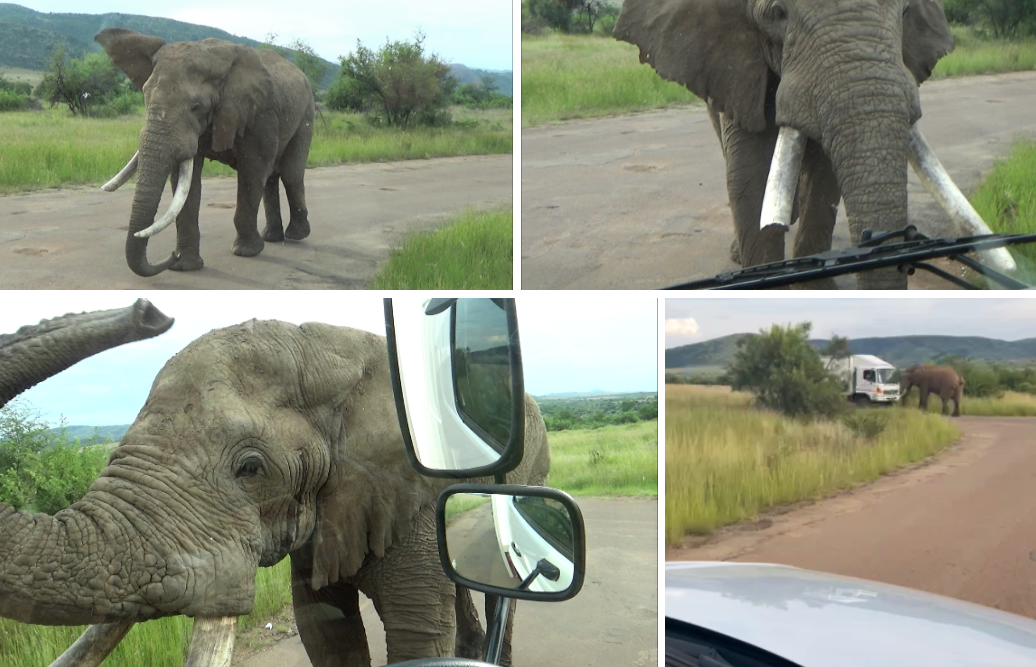
When the elephant disappeared down the road (with his string of admirers following him) we now really headed direction camp: enough excitement for one day!
In the dusk, on the last few km before we got to the gate, we passed our last close animal viewing: a tower of giraffes nibbling at the trees along the road side.
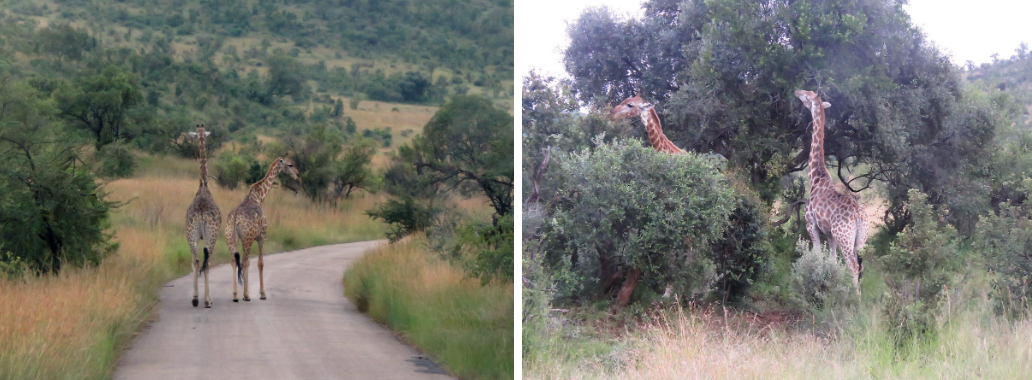
Pilanesberg didn’t disappoint! Three of the big cats, four of the Big 5, hippo’s and weird spiders, and even a brown hyena,… we had been spoilt for choice. I was a good weekend!
Enjoy the video.
.
For more photos, clips and videos follow us on


Pilanesberg